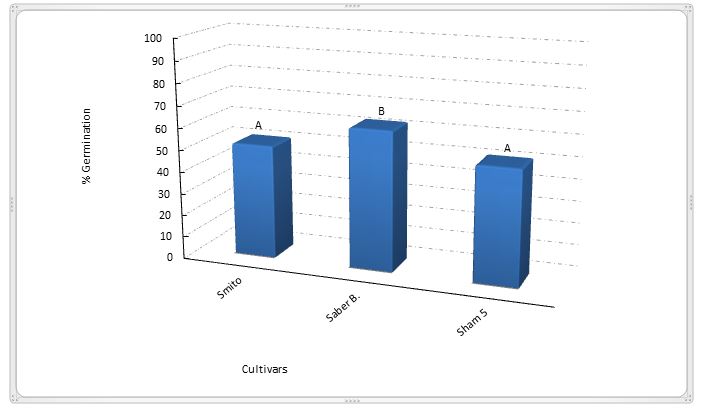Differences among three wheat cultivars in susceptibility to Fusarium culmorum and the effect of a number of bacterial strains on infested seed germination
DOI:
https://doi.org/10.21271/ZJPAS.35.4.11Keywords:
bacteria, biological control, Fusarium culmorum, resistance, wheat cultivar.Abstract
Wheat seedling blight caused by Fusarium culmorum, is one of the most common among wheat diseases. Last decades, use of resistant cultivars and biological control by antagonistic micro-organisms have received much attention. Resistance levels of three wheat cultivars (Saber Bag, Smito and Sham 5) to this disease was assessed under greenhouse conditions. None of the cultivars was high resistant but Saber Bag showed the highest germination rate 63.3%. This was 11% more than the two other cultivars.
In a dual culture three bacterial strains, two Bacillus and one Pseudomonas had very good effect in inhibition of the mycelium growth of this fungus. Bacterial strain Bacillus sp M1, B. subtilis K3 and Pseudomonas sp 53 inhibited the fungal mycelium growth by 100%, 97.5 %, and 98% respectively. In greenhouse experiments, bacterial strain M1 increased the number of seed germinations by 50% compared to untreated Fusarium control in cv. Sham5 and 43% in cv. Smito. Also strain 53 increased the number of germinations by 35% in cv. Smito.
References
Amein,T., Ome, Z., and Welch, C. (2008). Application and evaluation of Pseudomonas strains for biocontrol of wheat seedling blight. Crop Protection 27, 532–536.
Baehler, E., de Werra, P., Wick, LY., Péchy-Tarr, M., Mathys, S., Maurhofer, M., Keel, C. (2006). Two novel Mvat-like global regulators control exoproduct formation and biocontrol activity in root-associated Pseudomonas fluorescens CHAO. Mol. Plant-Microbe Interact. 19: 313-329.
Bouanaka, H., Bellil, I., Harrat, W., Boussaha, S., Benbelkacem, A., Khelifi, D. (2021).On the biocontrol by Trichoderma afroharzianum against Fusarium culmorum responsible of fusarium head blight and crown rot of wheat in Algeria. Egyptian Journal of Biological Pest Control. 31:68. https://doi.org/10.1186/s41938-021-00416-3
Cazorla, FM., Dukett, SB., Berström, ET., Noreen, S., Odijk, R., Lugtenberg, BJJ., Thomas-Oates, JE., Bloemberg, GV. (2006). Biocontrol of avocado Dematophora root rot by antagonistic Pseudomonas fluorescens PCL1606 correlates with the production of 2-hexyl 5 propyl resorcinol. Mol. Plant-Microbe Interact. 10:79-86.
Chrpová, J., Šíp, V., Matějová, E., and Sýkorová, S. (2007). Resistance of Winter Wheat Varieties Registered in the Czech Republic to Mycotoxin Accumulation in Grain Following Inoculation with Fusarium culmorum. Czech J. Genet. Plant Breed, 43, (2): 44–52.
Cook, R. J. (1993). Making greater use of introduced microorganisms for biological control of plant pathogens. Annual Review of Phytopathology 31, 53–80.
Dean, R., van Kan, J.A.L., Pretorius, Z.A., Hammond-K, K.E., Di Pietro, A., Spanu, P.D., Rudd, J.J., Dickman, M.; Kahmann, R., Ellis, J., et al. (2012). The top-10 fungal pathogens in molecular plant pathology. Plant Pathol. 13, 414–430.
De Souza, JT., Weller DMJ., Raaijmakers M. (2003) Frequency, diversity, and activity of 2,4-diacetylphloroglucinol-producing fluorescent Pseudomonas spp. in Dutch take-all decline soils. J Phytopathology, 93 (1):54-63.
Djordje, F., Dimkić, I., Berić, T., Lozo, J., Stanković, S. (2018). Biological control of plant pathogens by Bacillus species. Journal of Biotechnology. Vol. 285, 44 -55.
Dunlap, C.A., Schisler, D.A.; Price, N.P.; Vaughn, S.F. (2011). Cyclic lipopeptide profile of three Bacillus subtilis strains; antagonists of Fusarium head blight. J. Microbiol. 49, 603–609.
Gosmana, N., Baylesa, R., Jenningsb, P., Kirbyc, J., and Nicholsonc, P. (2007). Evaluation and characterization of resistance to fusarium head blight caused by Fusarium culmorum in UK winter wheat. Plant Pathology. 56, 264– 276.
Guo, Q., Dong, W., Li, S., Lu, X., Wang, P., Zhang, X., Wang, Y., Ma, P. (2014). Fengycin produced by Bacillus subtilis NCD-2 plays a major role in biocontrol of cotton seedling damping-off disease. Microbiol. 169, 533–540.
Johnssson, L., Ho¨ geberg, M., Gerhardson, B. (1998). Performance of the Pseudomonas chlororaphis biocontrol agent MA 342 against cereal seed-borne diseases in field experiments. Eur. J Plant Pathol. 104,701–711.
Khan, M.R., Fischer, S., Egan, D., Doohan, F.M. (2006). Biological control of Fusarium seedling blight disease of wheat and barley. Phytopathology 96, 386–394.
Khan, N.I., Schisler, D.A., Boehm, M.J., Lipps, P.E., and Slininger, P.J. (2004). Field testing of antagonists of Fusarium head blight incited by Gibberella zeae, Field testing of antagonists of Fusarium head blight incited by Gibberella zea. Biological Control 29, 245–255.
Khayalethu N., Lesiba K L, Molemi E R., Oluwafemi A A., and Patrick B N. (2019). The Mode of Action of Bacillus Species against Fusarium graminearum. Tools for Investigation and Future Prospects. Toxins MDPI. 1 – 14.
Kowalska, J., Tyburski, J., Krzymińska, J. et al. (2021). Effects of seed treatment with mustard meal in control of Fusarium culmorum Sacc. and the growth of common wheat (Triticum aestivum ssp. vulgare). Eur J Plant Pathol 159, 327–338. https://doi.org/10.1007/s10658-020-02165-9.
Leslie, J., Summerell, B. (2006). The Fusarium Laboratory Manual. Blackwell Publishing, IA. pp.388.
Liddell, C. (1991). Recent Advances in Fusarium Systematics. Phytopathology. 81: 1044-1045.
Logrieco A., Moretti A., Perrone G., Mule G. (2007). Biodiversity of complexes of mycotoxigenicfungal species associated with Fusarium ear rot of maize and Aspergillus rot of grape. International Journal of Food Microbiology. 119: 11- 16.
Meyer, JB., Lutz, MP., Frapolli, M., Péchy-Tarr, M., Rochat, L., Keel, Ch., Défago, G., Maurhofer, M. (2010). Interplay between Wheat Cultivars, Biocontrol Pseudomonads, and Soil. J Appl Environ Microbiol 76:6196–6204. Narayanasamy P. (2013). Biological Management of Diseases of Crops: Volume 1:
Characteristics of Biological Control Agents. 673 page.
Nelson, D.E., Desjardins, A.E., and Plattner, R.D. (1993). Fumonisins, mycotoxins produced by Fusarium species: biology, chemistry and significance. Annual Review Phytopathology, 31:233-252.
Noor K., Maskit M. and Ann M. H. (2017). Combating Fusarium Infection Using Bacillus Based Antimicrobials. Review. Microorganism. 5, 75. p 2 – 13.
Parry, D.W., Jenkinson, P., and Mcleod, L. (1995). Fusarium ear blight (scab) in small grain cereals. Review Plant Pathology, 44: 207-238.
Orakci, G. E., Morgounov, A., Dababat, A. A. (2018). Determination of Resistance in Winter Wheat Genotypes to the Dryland Root Rots Caused by Fusarium culmorum in Turkey. International Journal of Agriculture and Wildlife Science (IJAWS), 4(2): 193 – 202.
Rebib H., Hedi A., Rousset M., Boudabous A., Limam F. and Sadfi – Z.N. (2012).Biological control of Fusarium foot rot of wheat using fengycin-producing Bacillus subtilis isolated from salty soil. African Journal of Biotechnology Vol. 11(34), pp. 8464-8475.
Savary, S., Ficke, A., Aubertot, J.N., Hollier, C. (2012). Crop losses due to diseases and their implications for global food production losses and food security. Food Secur. 4, 519–537.
Savary, S., Willocquet, L., Pethybridge, S.J., Esker, P., McRoberts, N., Nelson, A. (2019). The global burden of pathogens and pests on major food crops. Nat. Ecol. Food Evol. 3, 430–439.
Scherm, B., balmas, V., Spanu, F., Pani, G., Delogu, I., Pasquali, M., and Migheli, Q. (2013). Fusarium culmorum: causal agent of foot and root rot and head blight on wheat. Molecular Plant Pathology 14 (4), 323–341.
Šíp, V., Chrpová, J., and Štočková, L. (2011). Evaluation of Resistance to Fusarium Head Blight in Wheat Using Different Sources of Inoculum. Czech J. Genet. Plant Breed. 47, (4): 131–139.
Summerell, B., Salleh B., Leslie J. (2003). A utilitarian approach to Fusarium identification. Plant Disease. 87 (2): 117-128.
Tinivella, F., Hirata, L. M., Celan, M. A., et al. (2009). Control of seed-borne pathogens on legumes by microbial and other alternative seed treatments. European J. of Plant Pathology. 123: 139 – 151.
Weller, D. M. (1988). Biological control of soilborne plant pathogens in the rhizosphere with bacteria. Annual Review of Phytopathology 26, 379–407.
Weller, DJ. (2007). Pseudomonas biocontrol agents of soilborne pathogens: looking back over 30 years. J Phytopathology 97 (2):250–256.
Wissuwa, M., Mazzola, M., Picard, C. (2009). Novel approaches in plant breeding for rhizosphere-related traits. J Plant Soil 321:409–430.
Wiśniewska H, Kowalczyk K. (2005). Resistance of cultivars and breeding lines of spring wheat to Fusarium culmorum and powdery mildew. J. Appl. Genet.46(1):35-40.

Downloads
Published
How to Cite
Issue
Section
License
Copyright (c) 2023 Tahsein A. M. Amein

This work is licensed under a Creative Commons Attribution 4.0 International License.













